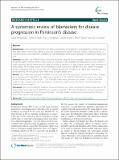Files in this item
A systematic review of biomarkers for disease progression in Parkinson's disease
Item metadata
| dc.contributor.author | McGhee, David J. M. | |
| dc.contributor.author | Royle, Pamela L. | |
| dc.contributor.author | Thompson, Paul A. | |
| dc.contributor.author | Wright, David E. | |
| dc.contributor.author | Zajicek, John P. | |
| dc.contributor.author | Counsell, Carl E. | |
| dc.date.accessioned | 2016-09-16T11:30:12Z | |
| dc.date.available | 2016-09-16T11:30:12Z | |
| dc.date.issued | 2013-04-12 | |
| dc.identifier | 242656229 | |
| dc.identifier | 8f93746a-d24b-4875-9be5-61b99a3bd972 | |
| dc.identifier | 23587062 | |
| dc.identifier | 84877070118 | |
| dc.identifier.citation | McGhee , D J M , Royle , P L , Thompson , P A , Wright , D E , Zajicek , J P & Counsell , C E 2013 , ' A systematic review of biomarkers for disease progression in Parkinson's disease ' , BMC Neurology , vol. 13 , 35 . https://doi.org/10.1186/1471-2377-13-35 | en |
| dc.identifier.issn | 1471-2377 | |
| dc.identifier.other | ORCID: /0000-0003-3481-825X/work/64034651 | |
| dc.identifier.uri | https://hdl.handle.net/10023/9514 | |
| dc.description | This article presents independent research funded by the National Institute for Health Research (NIHR) under its Programme Grants for Applied Research Programme (Grant Reference Number RP-PG-0707-10124). | en |
| dc.description.abstract | BACKGROUND: Using surrogate biomarkers for disease progression as endpoints in neuroprotective clinical trials may help differentiate symptomatic effects of potential neuroprotective agents from true disease-modifying effects. A systematic review was undertaken to determine what biomarkers for disease progression in Parkinson's disease (PD) exist. METHODS: MEDLINE and EMBASE (1950-2010) were searched using five search strategies. Abstracts were assessed to identify papers meriting review in full. Studies of participants with idiopathic PD diagnosed by formal criteria or clearly described clinical means were included. We made no restriction on age, disease duration, drug treatment, or study design. We included studies which attempted to draw associations between any tests used to investigate disease progression and any clinical measures of disease progression. The electronic search was validated by hand-searching the two journals from which most included articles came. RESULTS: 183 studies were included: 163 (89%) cross-sectional, 20 (11%) longitudinal. The electronic search strategy had a sensitivity of 71.4% (95% CI 51.1-86.0) and a specificity of 97.1% (95% CI 96.5-97.7). In longitudinal studies median follow-up was 2.0 years (IQR 1.1-3.5). Included studies were generally poor quality--cross-sectional with small numbers of participants, applying excessive inclusion/exclusion criteria, with flawed methodologies and simplistic statistical analyses. CONCLUSION: We found insufficient evidence to recommend the use of any biomarker for disease progression in PD clinical trials, which may simply reflect the poor quality of research in this area. We therefore present a provisional 'roadmap' for conducting future disease progression biomarker studies, and recommend new quality criteria by which future studies may be judged. | |
| dc.format.extent | 13 | |
| dc.format.extent | 451610 | |
| dc.language.iso | eng | |
| dc.relation.ispartof | BMC Neurology | en |
| dc.subject | Biomarkers | en |
| dc.subject | Disease Progression | en |
| dc.subject | Humans | en |
| dc.subject | Parkinson Disease | en |
| dc.subject | Clinical trials | en |
| dc.subject | Neuroprotective agents | en |
| dc.subject | RC0321 Neuroscience. Biological psychiatry. Neuropsychiatry | en |
| dc.subject.lcc | RC0321 | en |
| dc.title | A systematic review of biomarkers for disease progression in Parkinson's disease | en |
| dc.type | Journal article | en |
| dc.contributor.institution | University of St Andrews. School of Medicine | en |
| dc.identifier.doi | https://doi.org/10.1186/1471-2377-13-35 | |
| dc.description.status | Peer reviewed | en |
This item appears in the following Collection(s)
Items in the St Andrews Research Repository are protected by copyright, with all rights reserved, unless otherwise indicated.

